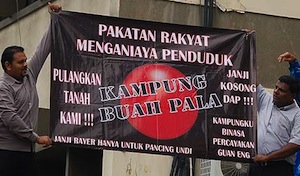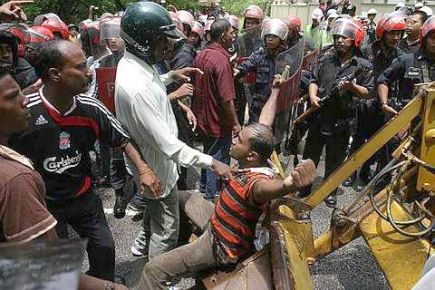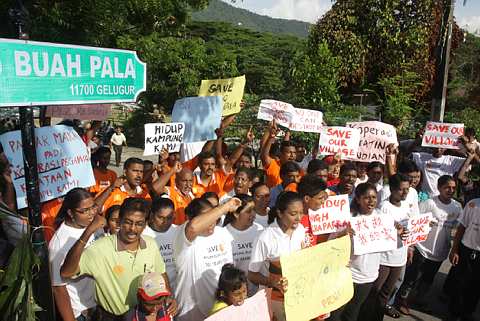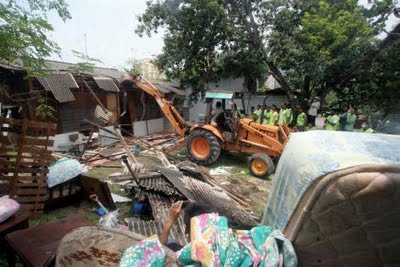Kampung Buah Pala revisited
(This article is an edited version of one that was written in March 2010)
Raggie Jessy
H.L. Mencken once put it: “each party in a democratic nation devotes its chief energies towards proving the other unfit to rule, with both commonly succeeding in being right”.
Yes. Politics is a field where blunders are gloriously defended. It may have been the past Gerakan led Penang government that possibly ignited a political firestorm, but it is the present DAP led government which seems to have blundered forward.
The over-politicised Kg. Buah Pala strife revolves around a land mass spanning 2.6ha. Its acquisition by Koperasi Pegawai Kerajaan Pulau Pinang Berhad led to disputes, germinating with hoo-ha when squatters were served eviction notices by Nusmetro Ventures (P) Sdn. Bhd., the appointed developer.
Kampung Buah Pala is a locality within the confines of Penang’s Gelugor township, which poses as a gateway to the isle’s end of the famed Penang Bridge. Essentially a Tamil settlement, its name is an eponym for nutmegs, with credit due to a certain Englishman named David Brown, who naturalised the commodity therein.
An entrepreneur of sorts, Brown contributed immensely to Penang’s agricultural landscape and was cherished by the Indian commoner of the era. The establishment of Periya Thottam in Gelugor (a.k.a. the Gelugor Estate) punctuated Brown’s association with the Indian community with a sense of intimacy that spanned two generations. The Estate was famed for its variety in spices, along with settlements of cattle breeders who mushroomed over the years. The village came to be known as the High Chaparral owing to its altitude and the dense vegetation that enveloped its terrains.
Brown’s estate covered much of today’s Gelugor and Minden townships, and included vast terrains of plantations in Ayer Gajah (now a residential neighborhood at Jalan Tunku Abdul Rahman), Sungai Ara (now a residential township known as Taman Kenari) and Strawberry Hill (on Penang Hill). Indian settlements, which sprang out of these plantations, extended all the way to Batu Uban from Bukit Dumbar, and are now held to be endemic to this neck of the woods.
But plantations gradually dwindled in size owing to the rapid urbanization of vicinal districts. The Brown family, through Helen Margaret Brown, consigned Kampung Buah Pala in trust to the Government of the Straits Settlement before returning to England. The estate ceased operations in 1956, with the land trust being transferred to the State Government. Villagers were thence issued Temporary Occupation Licenses (TOL).
In 2001, Koperasi Pegawai-Pegawai Kanan Kerajaan Pulau Pinang Berhad (KPKKNPP) applied to purchase 6.5 acres of land in Kampung Buah Pala. Succeeding this, 34 TOLs were issued to residential owners, despite there being 43 houses existing within its confines. In September the following year, the land commission agreed to KPKKNPP’s purchase of the disputed territory.
Two months later, then Chief Minister Tan Sri Dr. Koh Tsu Koon intervened by requesting that an approval be hinged on a proposal to erect 647 apartment and 12 retail units on the said land. The State EXCO proceeded to approve the application twice, once in August, 2004 and another in June, 2005, with the land value negotiated at a premium of MYR 6.42 million.
Events took an unforeseen turn when the purchaser was granted a 50% discount of the premium in April 2007. The maneuver, prompted by the recommendation of then Deputy Chief Minister Dato’ Abdul Rashid Abdullah, undermined the value of the land at RM 10 per sq ft. Rest assured, occupants took a dim view of a package deal that put the kibosh on their claim to a long standing heritage.
But as Johann Wolfgang put it, “clever men commit no minor blunders”. Having said that, let us ditch the technical mumbo jumbo for a while. That is to say, let us put on our thinking caps and approach this with some good ol’ native judgment.
Now, land departments customarily evaluate real property based on the projected sales of development projects scheduled. Research would involve the examination of sales brochures, the monitoring of construction costs/interest rates, the analysis of projected development programs, the appraisal of socio-economic concerns and their impact, etc.
In forming an opinion, the evaluator would establish the maximum development permissible based upon circumstances prevailing and specific to the real property; this includes the land’s gazette, which predetermines the nature of activity allowable.
Having established this, let us examine further the controversy that surrounds Kampung Buah Pala in a manner that is non-partisan and objective.
1. The High Chaparral Declassified
Several scores that bore on the Kampung Buah Pala controversy were brought to my attention.
On the 16 July 2002, the State Northeast Land Administrator’s office (PTDTL) submitted Majlis Mesyuarat Kerajaan (MMK) papers on KPKKNPP’s proposal to the Land and Minerals office (PTG). It was PTDTL’s suggestion that the application be rejected on grounds that the MMK had previously rejected two applications; one by Tetuan Pembinaan Baufort Sdn. Bhd., and the other by Tetuan Edaran Pelita Sdn. Bhd.
Four months on, MMK was presented with the proposal by KPKKNPP, but deferred its decision on the matter. Koh Tsu Koon clearly sought for the erection of apartment and retail units on the affected land. However, Dato’ Koay Kar Huah of MCA motioned against such development, cautioning against the erection of tall structures on high altitudes. By far, that seemed the most sensible statement from a member to the State MMK.
In the same meeting, the Honorary SUK (Secretary to the State Government) clarified the need to recompense KPKKNPP for an about turn to a decision by the State Government in 1998.
Back then, KPKKNPP sought to purchase a plot of land adjacent to Dewan Sri Pinang, which was then met with the State’s sanction. But that never happened. Instead, the land was deeded to the Federal Government for the construction of a court complex, since realized.
Notwithstanding, Koh Tsu Koon went further to suggest a reduction to the development density proposed earlier. This was to facilitate the State’s consideration to a reduced premium rate. The State Economic Planning Unit (UPEN) was hauled in and consigned the task of reviewing the development proposal. Thereafter, KPKKNPP’s application was met with two approvals, one on the 18th of August 2004, and the other on the 8th of June 2005.
Interestingly, the MMK did in fact charge for a temporal restraint in issuing an approval letter, demanding that the welfare of squatters be catered for. It went so far as to direct an assessment by the district office on squatter issues that had to do with the disputed land. A noble gesture undoubtedly, but somewhat pretentious; antecedent thereto, residents were never conferred with, nor were they aware of deliberations afoot.
An approval letter was granted a month following the second approval, with the land premium standing at MYR6,420,000.00. On 8 August 2005, KPKKNPP entered a plea that favored reduced premium rates, on grounds that aggregate costs concerning the squatters’ welfare stood at a staggering MYR 3 million. It led the Land Administrator to opine a 50% diminution to the premium.
A remission was sought the year after. In April, Koay Kar Huah and Subbiyah Palaniappan felt the need to further hash out the squatter placement program prior to deliberating on the appeal. In the same sitting, Dr. Teng Hock Nam (State Gerakan Chairman) adverted to the proposed discount by seeking for a revaluation. In his defense, Hock Nam put the depreciated value down as overly cheap for a prime property.
Now this is an unmitigated truth. Kg Buah Pala is what I’d term as a ship in a bottle; an enclave in the thicket of urbanized townships that include the Sungai Dua, Jelutong and Green Lane residential districts.
Let’s examine proximal territories a little further; Bayan Lepas, an important township conterminous with Bayan Baru, is synonymous to Penang’s International Airport as well as the Bayan Lepas Free Trade Zone. Conferred with Cybercity status in 2005, the territory boasts state of the art amenities and infrastructure relevant to businesses within this neck of the woods. Suntech @ Penang Cybercity, the first MSC designated building up the Northern half of Malaysia, stands as a testament to the advent of cyber-friendly infrastructure within the region.
Billions of Ringgit (in FDI) later, the region transformed into an industrial powerhouse, with spillovers effects felt as far as Batu Maung. An erstwhile fishing village in the hinterland, Batu Maung is now home to the World Fish Centre, a UNESCO owned research Institution. Rapid development of the Bayan Baru-Bayan Lepas-Batu Maung triangle engendered many of its commercial, industrial and financial dominions. The last I checked, a plot of land in a relatively reclusive hamlet at Batu Maung was priced at MYR 85 per square foot. And that was some four years back.
An eight-lane expressway links Batu Maung to Bayan Lepas and Gelugor, extending right up to Georgetown, the administrative centre of Penang. Popularly termed by locals as the Coastal Highway, it shortens door to door journeys by rerouting traffic from the hustle and bustle of inland routes, giving commuters immediate admission to crucial territories on the island, as well as the Penang Bridge to which it adjoins.
Today, Penang’s Free Trade Zone (FTZ) extends right up to Batu Maung, contributing further to its economic and infrastructural boom. With major players such as Motorola and Nippon Express aboard, the region flourished, with crinkles of territorial distinction diminished. The expansion resulted in the nascence of new commercial and residential townships such as the Queensbay waterfront, which boasts a large mall and seaview promenade. In 2010, a piece of land at Queensbay (hardly 10 km away from Gelugor) stood at MYR195 per square foot.
With the continued elaboration, population densities within these regions and conterminous territories increased. The rapid urbanisation of the region demanded for further improvements, which included the need to ameliorate transportation infrastructure. This ensued in the Bayan Baru-Gelugor elevated expressway, which cut-short journeys to the Airport and diverted traffic bound for Batu Maung or Teluk Kumbar from Gelugor.
Given the regional anatomy, one could hardly brush off prospects of business proliferation within the Bayan Lepas-Bayan Baru-Batu Maung golden triangle and beyond. Being the sole international gateway up North, Penang’s International Airport helped shape the Industrial climate and topography within the Northern Corridors of the Nation, simultaneously calling in activity that helped energize support industries nationwide.
A prominent landmark to these localities is Universiti Sains Malaysia. USM extended to investors opportunities towards a perpetual sense of research and development by bridging itself with industry, particularly through the School of Industrial Technology. With that, the North is and always has been set for business proliferation at runaway proportions.
MYR10 per square foot for a plot of land at Kampung Buah Pala? This surely qualifies for a bad joke. But that’s what its value was reduced to, with ensuing compensations by the then state government probably founded on the reduced aggregate.
As far as I would have it, the Gerakan led Penang state government blundered misreably. That said, DAP supplanted Gerakan to blunder forward where no government has blundered before, if the proceeding section is anything to go by.
2. Promises, promises, promises…
Now we can’t all be heroes, as somebody has to sit on the curb and clap as they go by. So I sat clapping as DAP’s RSN Rayer assured a people that Kampung Buah Pala would be preserved so long as Pakatan Rakyat ruled the state. And yes. I have had a passing acquaintance of sorts with Rayer.
Back then, I campaigned in favor of Koay Kar Huah against Karpal Singh for the Bukit Gelugor Parliamentary seat. In reminiscence, the affected village is a locality within the confines of Bukit Gelugor that includes the Seri Delima state constituency, succeeded by Rayer following a battle that saw him pitted against Loh Nam Hooi of MCA. Rayer was widely regarded as Karpal’s protégé by residents of Seri Delima.
Rayer took to position as the voice of Seri Delima at a time when people were inclined to vote for a nail in the wall, so long as it bore a Pakatan tag alongside.
Withal, Rayer avowed that Kg. Buah Pala would remain a standing village should Professor Dr. P. Ramasamy (of DAP) remain in power. “As long as the Tiger of Bukit Gelugor (Karpal) represents us, I am sure no one can enter our territory,” he was quoted to have said. Now, though Ramasamy and Karpal remained in power, neither could annul a legitimate contract that was actualised by a previous Gerakan led Government.
As a point of interest, Karpal succeeded to position as Member of Parliament following his triumph against Kar Huah in 2008. Rayer’s assurance to the people was communicated in Karpal’s presence on January the 18th, 2009. But Karpal reportedly advised Chief Minister Lim Guan Eng (of DAP) at a later date against attempts to arrest any transaction, in recognition of a legitimate contract that transferred the land title to KPKKNPP on March the 27th, 2008.
That’s right. The land title was finally transferred to KPKKNPP on the 27 March 2008 at a reduced premium of MYR10 per square foot, succeeding to an appeal tabled in 2005. The state Government and developer, Nusmetro Ventures (P) Sdn. Bhd., offered flats worth MYR75,000 to affected families, and relocation expenses of MYR1,000 per household.
In sharp contrast, the present Pakatan Government worked out a compensation plan of MYR8,000 in relocation expenses, compounding to a double-storey landed property with a 99 year lease worth MYR600,000. That said, the DAP led state Government was incapacitated in arresting the land transfer. The Federal Court further adjudicated that the present DAP led state Government was bound to decisions approved by the Koh Tsu Koon led state Government.
All said, are the people victims of a Gerakan led blunder or a DAP led flip-flop? You be the judge.





